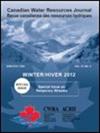克服数据贫乏地区流量预测的挑战
IF 1.7
4区 环境科学与生态学
Q3 WATER RESOURCES
引用次数: 0
摘要
摘要在安大略省,自然资源和林业部负责省级洪水预报和预警计划。安大略省PFFW计划的目标是降低洪水造成的生命损失、伤害和财产损失的风险。地表水监测中心(SWMC)通过每天为该省提供省级洪水灾害识别和风险评估(HIRA),履行MNRF的省级公共安全任务。SWMC使用各种工具来完成HIRA,然而,目前该省使用的监测工具套件中没有可用的洪水预测功能。安大略省洪水报告和安大略省洪水战略特别顾问强调,洪水预测是整体洪水管理的一部分。作为后续行动,在安大略省北部的塞文河进行了一项使用WATFLOOD®的试点研究,以探索在数据匮乏地区使用作战预测能力及其影响。该流域目前没有全年气象站。WATFLOOD非常适合在偏远和数据贫乏的地区应用,因为水文参数不是基于流域的,可以使用类似地理/气候领域的流域数据进行校准,例如哈德逊湾低地。本文将表明:来自更密集仪器区域的水文和路由参数可以应用于数据贫乏的区域;WATFLOOD可用于在数据贫乏的地区提供可接受的流量预测和校准;在数据贫乏的地区,可以使用数值天气模型数据而不是传统的测量数据来成功校准水文模型。本文章由计算机程序翻译,如有差异,请以英文原文为准。
Overcoming the challenges of flow forecasting in a data poor region
Abstract In Ontario, the Ministry of Natural Resources and Forestry (MNRF) is responsible for the provincial flood forecasting and warning (PFFW) program. The goal of Ontario’s PFFW program is to reduce the risk of loss of life, injury, and property damage due to flooding. The Surface Water Monitoring Centre (SWMC) fulfills MNRF’s provincial mandate for public safety by providing daily provincial scale Hazard Identification and Risk Assessment (HIRA) for flooding for the province at a provincial scale. The SWMC uses a variety of tools to complete the HIRA, however, there are currently no operational flood forecasting capabilities available within the suite of monitoring tools used by the province. Ontario’s Special Advisor on Flooding Report and the Ontario Flooding Strategy highlights flood forecasting as a part of overall flood management. As a follow up, a pilot study using WATFLOOD® was undertaken in the Severn River in Northern Ontario to explore the use and implications of operational forecasting capabilities in a data poor region. There are currently no year-round meteorological stations in this watershed. WATFLOOD is well suited for application in remote and data poor regions as the hydrological parameters are not watershed based and can be calibrated with data from watersheds in a similar physiographic/climatic domain – e.g. the Hudson Bay Lowlands. This paper will show: that hydrological and routing parameters from a more densely instrumented region can be applied to a data poor region; that WATFLOOD can be used to provide an acceptable flow forecast and calibration in a data-poor region; and Numerical weather model data, rather than conventional gauge data can be used to successfully calibrate a hydrological model in a data poor region.
求助全文
通过发布文献求助,成功后即可免费获取论文全文。
去求助
来源期刊

Canadian Water Resources Journal
WATER RESOURCES-
CiteScore
2.90
自引率
5.90%
发文量
17
审稿时长
>12 weeks
期刊介绍:
The Canadian Water Resources Journal accepts manuscripts in English or French and publishes abstracts in both official languages. Preference is given to manuscripts focusing on science and policy aspects of Canadian water management. Specifically, manuscripts should stimulate public awareness and understanding of Canada''s water resources, encourage recognition of the high priority of water as a resource, and provide new or increased knowledge on some aspect of Canada''s water.
The Canadian Water Resources Journal was first published in the fall of 1976 and it has grown in stature to be recognized as a quality and important publication in the water resources field.
 求助内容:
求助内容: 应助结果提醒方式:
应助结果提醒方式:


